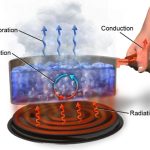Convection is how heat passes through fluids. A fluid is anything that has loosely moving molecules that can move easily from one place to another. Liquids and gases are fluids. One important property of fluids is that they rise when heated. That’s because the molecules spread out and move apart when they get hot. The hot fluid becomes less dense and rises up. Cooler fluid is less dense and so it sinks down. This up-and-down motion creates what are called convection currents. Convection currents are circular movements of heated fluids that help spread the heat.

Here’s an example. Last night I heated up soup for dinner. Yum! At first, the soup was cold in the pan. The soup at the bottom of the pan was closest to the hot stove burner, right? So the soup at the bottom heated up first. As it heated, the molecules spread apart and became less dense. So the heated soup rose up to the top. As the hot soup rose up, the cooler soup at the top sank down to the bottom. When it was at the bottom, it was closest to the heat, so THAT soup got hot and rose up.
As the soup continued heating, the hot soup rose and the cold soup sank. If you were to look closely, you would see the soup moving up and down in the pot. The up-and-down movement was a convection current. The convection current helped spread the heat around, until all of the soup was heated up. Convection currents explain why the air is hotter at the top of a room and cooler at the bottom. Convection currents also explain why water is warm at the top of the ocean, but gets colder as you swim deeper.
One natural example of convection currents is wind. As the Sun shines down on an area of land, it heats the air above the ground. That warm air rises. As it rises, cooler air moves in to take the place at the bottom. This moving cooler air creates…wind! Wind happens all over Earth because Earth heats unevenly. There are always colder parts and warmer parts. The wind blows from the cooler parts of Earth to the warmer parts.

Other examples of convection are: boiling a pot of water on the stove; using a hot radiator to warm the air in a room; and using heated air to make a hot-air balloon rise up into the sky.


